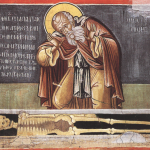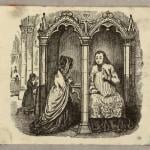SUPERHERO COMICS AND THE SPANISH TRAGEDY. This past summer I had a terrific surge of fiction-writing energy, after a long spell of torpor. I’m still working on lots of fun stories, and I love it. So much more fun than journalism! I’ve had a host of ideas that I really like, jumping-off points for stories. Right now I’ve got two rough drafts done, two mostly-done, and seven in various stages of draft or notes. This is wildly exciting, given that until this summer I hadn’t actually finished a work of fiction since college.
Anyway, people ask you where you get your ideas. And it was really obvious to me that I was getting both many of my ideas, and a huge infusion of writing-energy, from the comics I started reading some time in, I think, June. Of those ten stories, three are very heavily influenced by comics (although that’ll only be made glaringly evident in the title of one of the stories; all three of the heavy-influence ones will be totally intelligible to non-comics-readers), and five have various chunks of comics-inspired imagery or plot ideas.
So, lots of influence there. And it was especially striking to me that although I read all different kinds of comics, from Essential Uncanny X-Men #1 to Like a River and Slow News Day, the comics that were sparking my fiction-brain were all very up-front Marvel superhero titles.
How come? Why were New X-Men and Daredevil, which I know are not the best, most artistically great comics out there (although I really love them, and you should too!), turning up the heat under the fiction cooker?
It’s because of the same thing that often frustrates people who dislike superhero comics: the conventions. Superhero comics are hemmed in by iron webs of convention. Everything from the double-initial names (Reed Richards, Matt Murdock, Lex Luthor) to the teeth-grinding lameness that is “retroactive continuity.” (Yeah, I know, technically that’s not a “convention,” but if you know what a retcon is I think you know exactly what I mean.)
I don’t think I would have realized that the conventions (which are often so constraining to the comics themselves) were what was inspiring me if I hadn’t written a paper a while back comparing Hamlet with Thomas Kyd’s Spanish Tragedy. Shakespeare swiped scads of plot devices from Kyd, and both used conventional revenge-tragedy elements.
But. Here are several quotes from that old paper (sorry for occasional clunky phrasing): “…Hamlet cracks and shifts the revenge tragedy the way that the roots of a tree will break through concrete….
“Several figures or ideas appear in both plays, the first to appear being the ghosts. Both of these ghosts appear within the first scene, to warn of the murder committed just before each play began. In The Spanish Tragedy the ghost’s speech and the allegorical character Revenge’s response encapsulate the entire play: it will be one long sweep from the ‘forc[ed] divorce between my love and me’ to the time when ‘thou shalt see the author of thy death… Depriv’d of life…’ The audience settles down, preparing to spend an enjoyable evening watching to see how Kyd gets from point A to point B…. Throughout the play the ghost reappears, as in Hamlet, to bemoan the way that no one seems to be taking revenge fast enough…. [The ghost] confers with Revenge, and is reassured that the play will end as a revenge tragedy should, with the deaths of the villains…. Where Kyd takes pains to tell his audience that he will not stray from the path, no matter how long it takes him to reach his destination, Shakespeare sends a far more confusing message. The first appearance of the ghost [in Hamlet] adds to the mystery rather than clearing it up; later, the ghost receives no guarantees that Hamlet will carry out his vengeance. The audience, left altogether unclear as to what path Shakespeare is treading, focuses on the characters instead of the plot. The movement toward the bloody ending, which seems so inevitable in The Spanish Tragedy, is quite uncertain in Hamlet–because Shakespeare has selected as his main character a man so ill-equipped to play the vengeful hero that he actually spends most of the play berating himself because he is trapped in the wrong plot, the wrong genre. Thus Shakespeare uses Kyd’s ghost to produce the opposite effect.
“The play-within-a-play in The Spanish Tragedy works similarly [see what I mean about clunky phrasing?–ed]. What Hieronimo and Bellimperia, the revengers, need is a way to get close to the murderers, while holding weapons. The play provides a costume for their intentions. Straightforward plot advancement, if very well done. In Hamlet, on the other hand, Hamlet’s purpose in devising the play-within-a-play is based on ideas rather than plot concerns. He wishes not to end Claudius’s life through ‘The Murder of Gonzago,’ but to ‘catch [his] conscience.’ This difference reflects the way that Shakespeare’s play takes its cues from Hamlet himself; it is more concerned with ideas, with proving that the ghost was truthful and that therefore Hamlet’s revenge would be justified. The Spanish Tragedy never stops to consider the consequences of vengeance; after all, it’s a revenge tragedy, and its purpose is to get us to the final scene, where everyone is dead.
“…For any revenge play to work, there has to be some delay…. In The Spanish Tragedy, the delay is mainly caused due to lack of opportunity. …In Hamlet, Shakespeare explicitly refuses to use this kind of delay; he actually presents Hamlet with the perfect opportunity to kill Claudius, and even sets the scene directly after ‘The Mousetrap’ provides proof of the King’s wrongdoing. Hamlet’s reasons for not running Claudius through then and there have to do with his own caught conscience, and his vision of the murderer-King ascending to heaven; he stalls because of the play’s metaphysics, not its machinery. …
“Hamlet’s character drives most of the plot of Shakespeare’s play in a way that no character seems to in Kyd’s. However, his is not the only vivid personality in the play, and this is part of the reason that The Spanish Tragedy feels like a court story, while Hamlet is moreof a family story. In a court, positions matter more than personalities or family relationships; the same could be said of the revenge tragedy, where a character’s position as bereaved father or wronged wife forms the entirety of his or her personality. …Shakespeare seems to have created a set of characters, confronted them with a plot line they cannot live up to, and then shoehorned them into it anyway to see what would happen. …
“…In describing Kyd’s play as a tragedy, one refers to a particular style, a set plotline and conventions, and a purpose which Hamlet does not share. Shakespeare was not trying to write a ‘tragedy’ in that sense; he was trying, in fact, to write around it, to use it as a frame which his ideas and his characters could crack in some places, cover in others, twine around in others. …In fact, Shakespeare compares the players’ reactions to their roles ‘in a fiction, a dream of passion’ to Hamlet’s far less satisfactory response to a similar situation, thus pointing out the way that Hamlet has outgrown its genre. Rather than hammering home an already-made point, however, the comparison adds both subtlety and pathos; Hamlet knows all about the conventions of tragedy, and he realizes that he is breaking them, and he cannot use that to his advantage as Shakespeare does in the writing of his play.”
Okay. So. My point (and I do have one!) is that conventions, especially conventions used without much thought, are opportunities for writers. Because we look at the machinery and the trappings and the tropes and ask, “Well, but what if that meant something, instead of just doing something?” What if the ghost was a problem, not a plot mechanism? What if the play-within-a-play was metaphysical, not strategic?
The three most heavily superhero-influenced stories I’m working on are all trying to ask questions like that. You don’t have to know anything about the genre conventions to read them (although I expect it would make your experience of the stories a bit richer), just as you don’t have to know the conventions of the Elizabethan revenge tragedy to be awed and changed by Hamlet (although knowing those conventions will make Shakespeare’s achievements all the more obvious and powerful).
There are countless levels to Hamlet; here are three: revenge tragedy, commentary on revenge tragedies, commentary on characteristic difficulties of human existence. If Hamlet were just a revision or satire or takedown of an Elizabethan dramatic genre, we wouldn’t care too much today. Similarly, there have been scores of attempts to Hamlet-ize superhero conventions, but most of them end up just being comics about comics, and really, what’s the point? I want to do something that works on all three levels, but mostly the first (basic story) and third (human condition).
The thing comics-about-comics forget is that superhero conventions arise for a reason. They speak to something–sometimes a good thing, sometimes a rotten thing–in human nature. They resonate. That resonance–what it reveals, what it obscures, what it gets wrong about the world and what it gets right–is what your story should be about. (You know who did this really well? Michael Chabon, in The Amazing Adventures of Kavalier & Clay. If this post intrigued you, I definitely recommend that book.)
Finally, I realized, typing this out, that one of the three most-comics-influenced stories, “Failure,” is in part about the situation I describe here: “Hamlet knows all about the conventions of tragedy, and he realizes that he is breaking them, and he cannot use that to his advantage as Shakespeare does in the writing of his play.”
So. A scattered post about conventions as inspirations. I can’t believe I compared myself to Shakespeare. Off to scrub myself with the Loofah of Humility. Anyway, I hope this whets your appetite for the stories to come!











